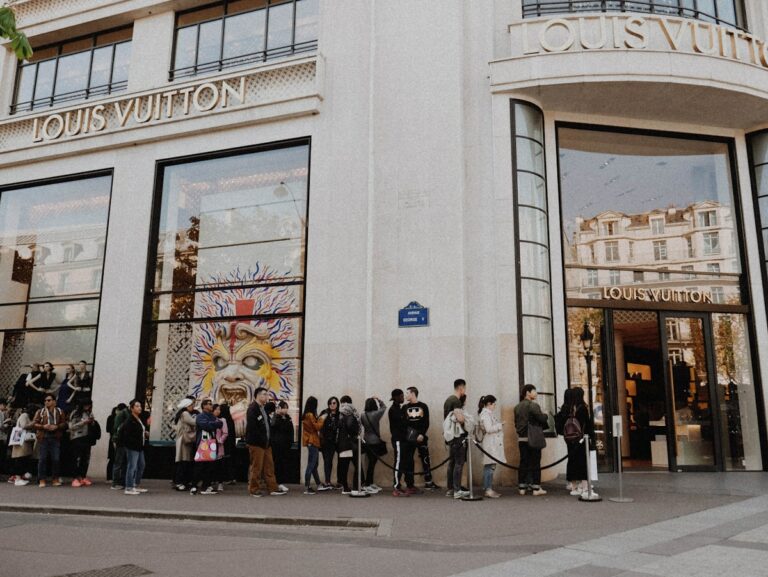As the festive season approaches and winter celebrations draw near, the streets transform into a magical spectacle of twinkling lights and lavish holiday displays. For many of us, one of the most enchanting aspects of this time of year is the simple yet timeless joy of window shopping. Strolling past shop windows is hard to ignore those carefully curated luxury items stirring a sense of wonder and excitement.
Whether it’s the latest designer shoes or the fantasy of an extravagant new Afghan rug, the magic of these displays ignites both our imaginations and desires—offering a moment of indulgence, even if just through the glass.
Looking at the glittering displays as the holiday is approaching makes me think of the psychological cost of doom spending casts a shadow over this seasonal magic. While shopping can provide a temporary boost in mood, it often serves as a bandage for deeper emotional anxieties. For many, especially younger generations, this impulse to spend is driven by a pessimistic view of the future. Facing economic uncertainty, unattainable housing, and stagnant wages, they turn to luxury purchases as a way to regain control or escape from reality. Yet, this form of emotional spending can create a vicious cycle—short-term gratification followed by long-term regret.
The psychological cost of doom spending extends beyond financial strain. As debt accumulates, feelings of guilt, anxiety and stress often intensify, leading to a sense of helplessness. What begins as a momentary act of self-care or generosity can quickly spiral into emotional distress, trapping you in a cycle of overspending and regret.
Doom spending is deeply intertwined with the emotional and economic anxieties faced by younger generations. These anxieties are largely driven by mounting financial pressures, coupled with the uncertainty surrounding the future. As the cost of living surges, particularly in housing and healthcare, many young adults feel overwhelmed by their inability to meet traditional milestones like buying a home, saving for retirement, or even starting a family. This economic stress is compounded by broader societal issues, such as climate change and political instability, which further exacerbate a sense of helplessness.
Emotional Anxiety as a Trigger
Psychologically, emotional anxiety plays a central role in prompting doom spending. As highlighted by psychologists, consumerism has long been a form of retail therapy—a coping mechanism that provides short-term relief from stress. However, in the case of doom spending, this temporary fix is often taken to extreme levels, as people attempt to soothe the emotional turmoil caused by a perceived bleak future. The notion that “the future is uncertain, so we may as well enjoy the present” becomes a prevailing mindset for many young people.

This is supported by research indicating that purchasing luxury goods or experiences, such as expensive vacations or high-end clothing, offers a fleeting sense of control and self-indulgence.
In the face of unrelenting economic stressors, spending becomes a way to regain a sense of agency, even if only temporarily. However, this coping mechanism can lead to further emotional strain as individuals begin to realize that their spending is unsustainable, contributing to long-term financial instability.
Economic Anxiety and the Pressure of Expectations
The economic landscape that young people face today is a far cry from what previous generations experienced. Soaring property prices, high inflation, and stagnant wages have created a financial environment in which traditional goals like homeownership and long-term savings feel out of reach. A survey by Euronews highlights that many millennials and Gen Z express frustration that despite working hard, they still struggle to achieve these goals. As a result, they may adopt a “live for today” mentality, where they prioritise immediate gratification over long-term financial planning.
The instability of the job market, coupled with rising student debt, leaves many feeling that saving for the future is a futile endeavour. This kind of economic anxiety creates an emotional void that doom spending attempts to fill. The luxurious travel or designer purchases become a way to enjoy life, given the uncertainty that their future will allow for these pleasures.
The Psychological Costs of Doom Spending
While doom spending may provide temporary emotional relief, it often exacerbates anxiety in the long term. The cycle of spending and accumulating debt can lead to feelings of guilt and regret, which further amplifies emotional distress. This vicious cycle can prevent you from achieving any sense of financial stability, leading to more doom spending as you try to cope with mounting economic pressures.
Over time, this behaviour can contribute to a sense of disempowerment, as you become trapped in a cycle of consumerism, debt and anxiety. Financial experts warn that doom spending can have detrimental effects not only on your bank account but also on mental well-being. The stress of living paycheck to paycheck, or the fear of being unable to meet financial obligations, can contribute to chronic anxiety and depression.
Breaking the Cycle: Strategies for Managing Anxiety
Breaking the cycle of doom spending requires addressing the underlying emotional and economic anxieties. Mindfulness practices, such as meditation and journaling, can help you become more aware of your emotional triggers and develop healthier coping mechanisms. Additionally, financial literacy and education are key to helping young adults manage their money more effectively and reduce the impulse to spend on non-essentials.
Intentional spending helps shift the mindset from immediate gratification to long-term financial wellness,as you make your buying decisions based on actual needs rather than emotional impulses. Additionally, seeking social support, whether through therapy or community groups, can provide emotional relief without the financial costs associated with retail therapy.
The Psychological Impact of Doom Spending
Beyond just financial strain, doom spending takes a significant psychological toll on young people. The cycle of impulsive purchasing, particularly on luxuries and non-essentials, often leads to feelings of guilt and regret once the immediate emotional high subsides. Psychologically, this behaviour is akin to other forms of addiction, where temporary pleasure leads to long-term consequences that further aggravate the initial problem.
Economic uncertainty is a key driver. As inflation continues to rise and wages fail to keep pace with the cost of living, younger generations experience chronic stress and a pervasive sense of economic instability. When financial milestones such as purchasing a home or starting a family seem unattainable, the emotional response can be one of defeat. This manifests in doom spending, which becomes a form of self-sabotage—a way to feel some fleeting sense of control in a world where financial security feels elusive.
Social Media and the Doom Spending Cycle
The prevalence of social media intensifies this behaviour. Platforms like Instagram and TikTok are filled with influencers promoting a lifestyle of luxury, travel, and high-end products, creating a perpetual sense of comparison. Younger generations, particularly Gen Z, are bombarded with images of success that are often unattainable, driving them toward consumption in an effort to keep up with these social benchmarks. The culture of “treating yourself,” while often lighthearted, can be dangerous when combined with economic pessimism and feelings of inadequacy.
Furthermore, FOMO (fear of missing out) plays a large role. As young people scroll through their feeds and see peers enjoying extravagant vacations or the latest designer items, they may feel compelled to indulge, even when their financial situation does not support such purchases. The fear of being left behind socially can override practical financial considerations, pushing individuals further into the doom spending spiral.
Long-term Financial Consequences
In the long term, the consequences of doom spending extend beyond emotional distress. Failing to save or accumulate wealth now means a diminished ability to handle future financial shocks, such as medical emergencies, job losses, or unexpected expenses. Financial insecurity, compounded by debt from unnecessary spending, can create an environment of chronic stress.

This, in turn, has serious implications for mental health, leading to higher risks of anxiety, depression, and even physical health issues like insomnia or hypertension.
In extreme cases, it can lead to mounting credit card debt, which further compounds economic stress. The irony of doom spending is that the short-term relief it provides often deepens the longer-term problem, leaving individuals in a more precarious situation than before.
Rebuilding Financial and Emotional Well-being
Addressing the root causes of doom spending requires both financial and emotional interventions. On the financial side, increasing financial literacy can be a crucial step. Many young people lack basic knowledge about budgeting, saving, and investing, which makes them more susceptible to impulse spending. Educational programs focusing on financial planning and debt management can empower them to make more informed decisions and resist the urge to splurge on unnecessary items.
From an emotional standpoint, it’s important to recognize that the real issue often lies in stress management and coping mechanisms. Financial insecurity triggers feelings of helplessness and loss of control, which doom spending tries, unsuccessfully, to alleviate. By developing healthier habits to manage emotional distress, such as mindfulness, meditation, or even seeking therapy, individuals can reduce the impulse to engage in retail therapy as a way to self-soothe.
Finally, fostering a community-based approach to financial wellness could also be highly beneficial. Many financial behaviors are socially reinforced, especially among peer groups. By promoting a culture of saving and financial responsibility—through social media influencers or financial education campaigns—there may be a shift in how younger generations view consumption and wealth. This, combined with emotional resilience, could help curb the cycle of doom spending and lead to more stable financial futures.
“Doom Saving”?
In a world where young adults are increasingly pessimistic about their future, doom spending has become a common but destructive coping mechanism. The desire to find immediate relief from emotional and economic anxiety drives this behaviour, but it often leads to greater financial instability and emotional stress. Addressing doom spending requires a multifaceted approach that includes emotional support, financial education, and a shift in cultural attitudes toward consumption.
Some experts suggest promoting an alternative behaviour called “doom saving”—where the same emotional energy and urgency is channelled into saving and preparing for the future, rather than spending to fill an emotional void. This can provide a sense of security and control, which may ultimately bring more lasting emotional peace than a fleeting retail splurge.
Do you want to share your story and inspire our readers ? Know that YOUR EXPERTISE is paving the way for a fairer, happier society.





